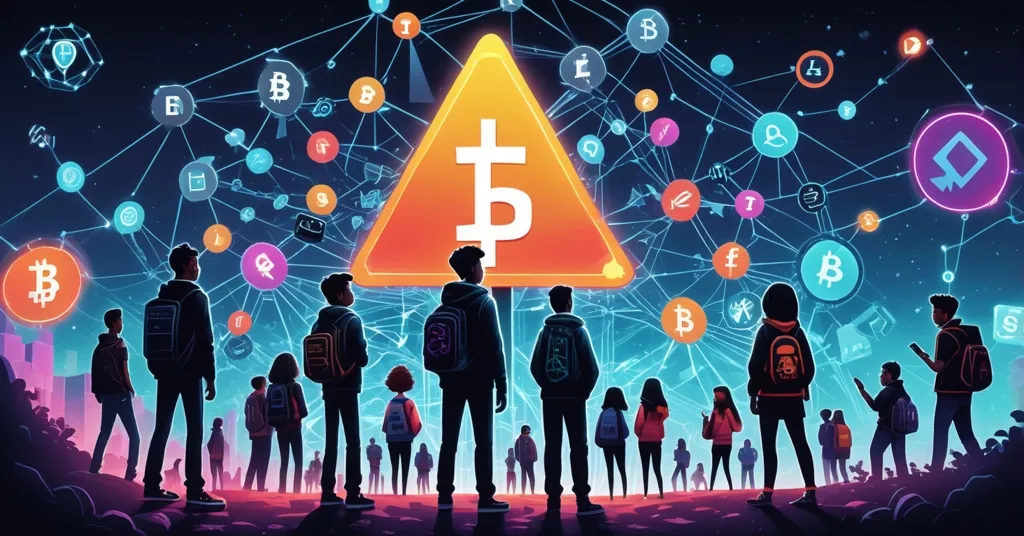EU Parliament Proposes 16+ Age Limit: Impact on Digital Freedom and Web3 Tech

EU Parliament’s 16+ Age Limit Proposal: A Safety Push with Ripple Effects for Digital Freedom
The European Parliament has fired a warning shot across the bow of Big Tech, passing a resolution with a landslide 483 votes in favor to set a default minimum age of 16 for accessing social media, video-sharing platforms, and AI chatbots across the EU. Aimed at shielding minors from online harms like cyberbullying, predatory creeps, and addictive algorithms, this move raises big questions about privacy, enforcement, and the future of digital freedom—especially for the decentralized, Web3 world we champion.
- EU Resolution: Proposes 16+ age limit for digital platforms, passed with strong support.
- Non-Binding: Just a political signal, not law—yet could shape future legislation.
- Crypto Angle: Decentralized tech could be a solution or a target in this safety crusade.
EU’s Bold Move for Child Safety
On Wednesday, the European Parliament made its stance clear: the internet isn’t a free-for-all playground anymore. With 483 votes in favor, 92 against, and 86 abstentions, lawmakers backed a resolution to establish a harmonized age limit of 16 as the default for accessing social media giants like TikTok or Instagram, video-sharing hubs like YouTube, and even AI tools such as chatbots. Kids aged 13 to 16 could still get in, but only with explicit parental consent. Under 13? No dice—full stop. This isn’t just a number slapped on a sign-up page; it’s a sweeping call to rethink how platforms operate, with teeth like potential bans for non-compliant services.
Let’s get one thing straight—this isn’t law yet. It’s a non-binding resolution, essentially a political megaphone shouting, “We mean business!” To become enforceable, the European Commission must draft formal legislation, and EU member states need to hash out the details through a slow, grinding negotiation process. Right now, age restrictions are a patchwork across the EU, guided by national laws under the Digital Services Act (DSA), a 2022 regulation that already forces platforms to prioritize user safety. But with mounting evidence tying social media to teen anxiety, depression, and worse, the push for a unified standard is gaining steam.
Global Push for Age Restrictions
The EU isn’t alone in this fight. Malaysia’s Communications Minister Fahmi Fadzil dropped a bombshell on November 23, announcing a ban on social media for under-16s by 2026, with mandatory identity verification for platforms rolling out next year. He framed it as a collective duty, saying:
“I believe that if the government, regulatory bodies, and parents all play their roles, we can ensure that the Internet in Malaysia is not only fast, widespread and affordable but most importantly, safe, especially for children and families.”
He added a nudge to tech companies, noting, “We hope by next year that social media platforms will comply with the government’s decision to bar those under the age of 16 from opening user accounts.”
Down under, Australia’s Prime Minister Anthony Albanese is also swinging for the fences, introducing legislation in late 2023 to ban social media for under-16s, with enforcement delayed 12 months post-passage and a review to follow. He pitched it directly to families:
“This one’s for the mums and dads. Social media is doing harm to our kids. And I’m calling time on it. I’ve spoken to thousands of parents, grandparents, aunties, and uncles. They, like me, are worried sick about the safety of our kids online. And I want Australian parents and families to know that the government has your back.”
The UK is riding this wave too, though details on their approach remain vague. Globally, the message is loud: the internet needs guardrails for kids, pronto.
Beyond Age Limits: Targeting Toxic Design
The EU resolution doesn’t stop at age gates. It takes aim at the sleazy underbelly of platform design—those addictive features engineered to keep users, especially teens, hooked for hours. Think infinite scrolling that never lets you look away, or constant notifications pinging your brain with dopamine hits. Then there’s autoplay on videos, reward systems that gamify engagement, and tailored ads so creepy they seem to read your mind. Studies, like those from the World Health Organization, have linked these tactics to skyrocketing stress and sleep issues in young users. The resolution wants them gone.
It also targets manipulative advertising—ads exploiting insecurities or pushing unrealistic ideals—and gambling-like mechanics such as loot boxes. For the uninitiated, loot boxes are randomized in-game purchases, akin to digital slot machines, often tricking kids into dropping real cash for virtual junk. Non-compliant platforms could face being blocked in the EU entirely, a sledgehammer approach that screams, “Shape up or get out.” It’s a noble goal, but let’s not pretend Big Tech will roll over without a fight. They’ve built empires on addiction—expect whining about “stifling innovation” while their algorithms keep kids glued.
Enforcement Challenges and Loopholes
Here’s where the rubber meets the road: how do you actually enforce this? Setting an age limit sounds nice, but teenagers aren’t exactly known for following rules. They’ll bypass restrictions with VPNs, borrowed accounts, or just straight-up lying about their birthdate—let’s face it, they could hack NASA with a flip phone; age gates are child’s play. And what about verification? Will platforms demand ID uploads, use third-party services, or lean on AI to guess ages from behavior? Each option reeks of privacy nightmares—centralized databases of kids’ data are a hacker’s wet dream.
There’s a darker flip side too. Push too hard, and you risk driving minors to shadier, unregulated corners of the internet—think dark web forums or sketchy decentralized apps with zero oversight. Cyberbullying and predators won’t vanish; they’ll just migrate. Plus, the cultural clash across EU states can’t be ignored. What’s acceptable screen time in Sweden might be scandalous in Spain. Harmonizing rules across 27 nations with different tech adoption rates and parenting norms is a bureaucratic dumpster fire waiting to happen. Safety is the goal, but overreach could backfire spectacularly.
Blockchain and Web3: Solution or Target?
Now, let’s pivot to our turf—how does this intersect with Bitcoin, blockchain, and the decentralized revolution? At first glance, social media bans seem unrelated to crypto, but dig deeper, and digital identity becomes the battleground. Decentralized platforms—Web3 social networks or blockchain-based content hubs—could either dodge these rules or get crushed by them. Their resistance to centralized control makes traditional regulation a headache. Will regulators label them loopholes and crack down harder? It’s a real risk.
On the flip side, blockchain tech could be the holy grail of privacy-first age verification. Enter zero-knowledge proofs, a cryptographic trick that lets someone prove they’re over 16 without spilling personal details. No ID uploads, no data hoarding—just math ensuring compliance while keeping your identity yours. Projects like Civic and SelfKey are already tinkering with decentralized identity solutions, aiming to let users control their data via blockchain. Imagine a world where kids verify age for platforms without Big Tech—or Big Government—snooping. It’s the kind of self-sovereignty Bitcoin OGs dream of.
But don’t pop the champagne yet. Adoption is a slog—most platforms won’t integrate niche crypto tools overnight. And regulators might not care about privacy if control is their endgame. They could demand backdoors or ban decentralized systems outright, claiming they’re “unsafe.” Plus, not every Web3 project is a saint; some could exploit lax oversight to become predator havens. The tension between safety mandates and the ethos of decentralization—freedom, privacy, no middlemen—is set to explode. Bitcoin itself might dodge direct hits, but if age verification creeps into wallets or exchanges, we’ve got a fight on our hands.
The Bigger Picture for Digital Freedom
Zoom out, and this EU resolution, paired with moves in Malaysia and Australia, marks a shift. The internet, once a wild frontier, is getting fenced in. Guardrails for kids sound noble—who doesn’t want to stop cyberbullying or curb teen screen addiction?—but the devil’s in the execution. Centralized control over who gets online, how, and when clashes hard with the principles of Bitcoin and Web3: an open, permissionless digital realm where individuals, not governments, hold the reins.
As regulators tighten the screws, will the untamed spirit of decentralization survive, or get choked out by “safety” laws? Could mandatory identity checks spill over into crypto spaces, undermining anonymity? These aren’t just hypotheticals; they’re the trillion-Satoshi questions shaping our future. For now, the EU’s proposal is a wake-up call. The fight for digital freedom isn’t just about code or coins—it’s about who controls access to the online world. And we’d better be ready to push back.
Key Questions and Takeaways on Digital Age Limits and Crypto Implications
- What’s driving the EU’s push for a 16+ age limit on social media and AI tools?
It’s fueled by real harms—cyberbullying, online predators, and addiction from platform designs—that have lawmakers scrambling to protect minors with stricter access rules. - Why isn’t this resolution enforceable, and what’s next?
It’s only a political statement; turning it into law requires the European Commission to draft legislation and EU states to agree, a slog that could take years. - How do Malaysia and Australia’s plans compare to the EU’s approach?
Malaysia’s under-16 ban by 2026 and Australia’s 2023 legislation with a delayed rollout are more actionable than the EU’s non-binding stance, showing faster global momentum. - What else does the EU resolution aim to tackle beyond age limits?
It targets addictive features like infinite scrolling, manipulative ads, and gambling-like loot boxes, with non-compliant platforms risking outright blocks in the EU. - How might enforcement stumble, and what are the risks?
Teens can dodge rules via VPNs or fake accounts, while verification methods raise privacy red flags; worse, kids might flock to unregulated, riskier digital spaces. - Can blockchain or Web3 offer solutions for online age verification?
Absolutely—zero-knowledge proofs and decentralized identity tools could confirm ages without data leaks, though adoption lags and regulators might stifle such innovation.

